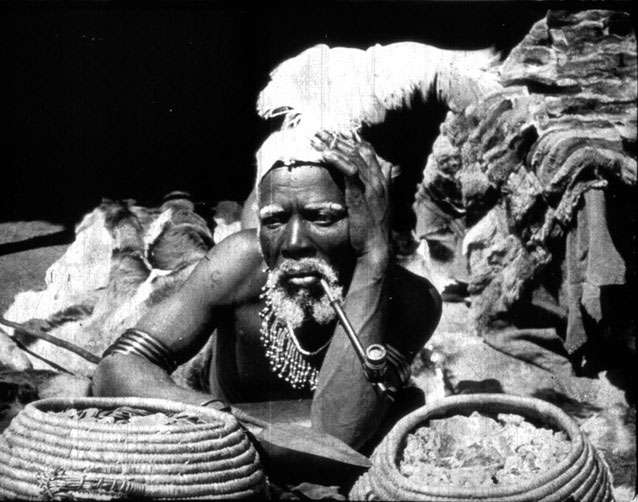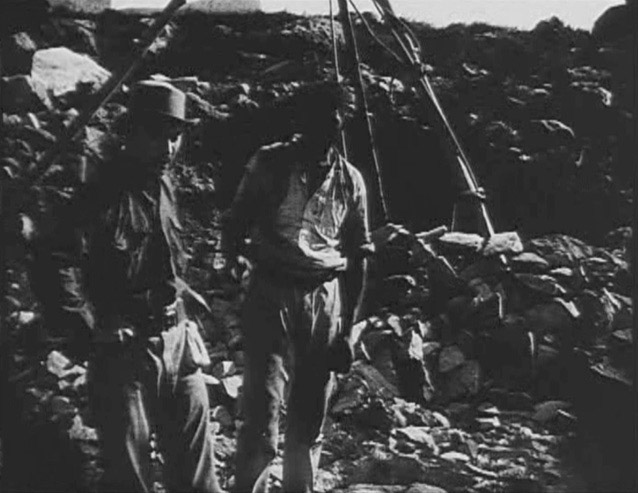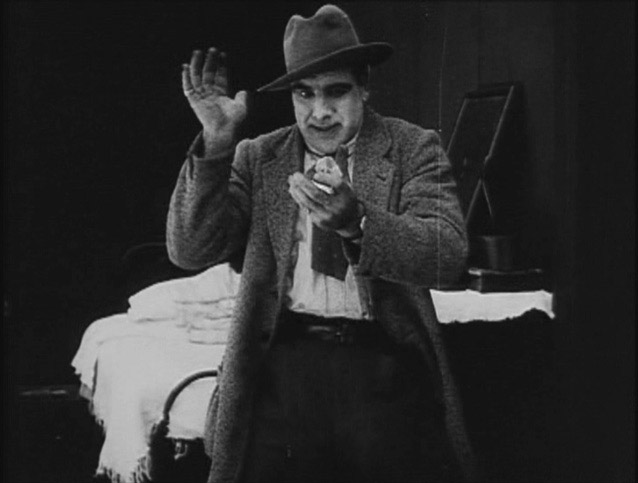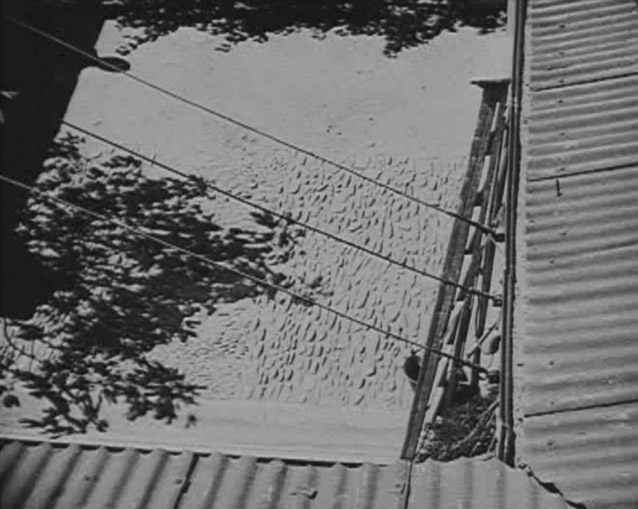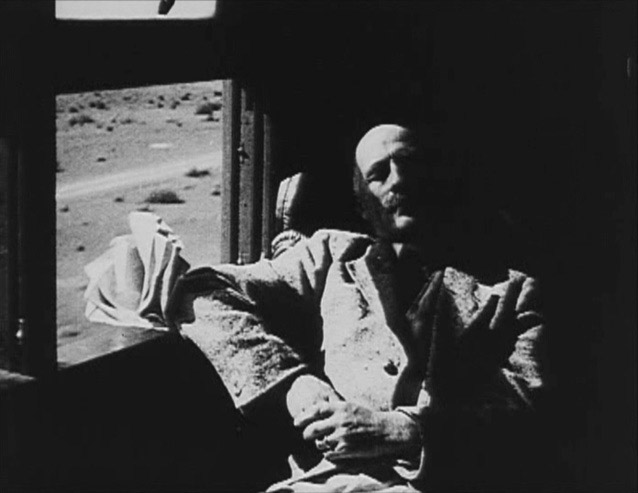Abstract
The South African feature film The Rose of Rhodesia was produced when the imperial romance, a genre associated in particular with Rider Haggard, enjoyed great popularity. Some of its typical features are to be found in The Rose of Rhodesia, but these are adapted and exceeded so as to speak to settler (rather than British) concerns in the early Union of South Africa. In the interaction between the three plots of the film one can discern disjunctive attempts at symbolically resolving contradictions between white and black interests, as well as between white classes, produced by the colonial capitalism of early twentieth-century South Africa.
……..
A striking feature of Harold Shaw’s The Rose of Rhodesia (1918) is its three distinct storylines. We have the story of Fred Winters’s theft of the diamond and his subsequent escape to the Karoo, the story of chief Ushakapilla and his son Mofti, and finally the narrative of Rose Randall, the miner’s daughter, and her ultimately successful search for a husband. According to the enthusiastic reviewer in the Kinematograph Weekly on 6 November 1919, “the three threads of the plot are woven together with exceptional skill”. I agree that they are woven together, but certainly not with exceptional skill—from a modern perspective, at least—and not all in the same way. On the contrary, the very failure of the storylines to meld seamlessly alerts us to underlying historical contradictions that the narrative attempts to overcome or suppress. The interesting question becomes, then, not only how but if—and, if so, why—the storylines are connected. Are the links contingent or necessary? If purely contingent, what does that tell us about the film’s fairly pronounced ambition to narrate the “now” in its colonial setting? If necessary, that is to say, produced by the inner logic of a narrative produced in the early days of the Union of South Africa, what kind of necessity are we looking at? Or, more to the point: whose needs are symbolically fulfilled by the narrative structure? These questions are, in general terms, informed by Fredric Jameson’s view of narrative as a socially symbolic act wherein “the aesthetic act is itself ideological, and the production of aesthetic or narrative form is to be seen as an ideological act in its own right, with the function of inventing imaginary or formal ‘solutions’ to unresolvable social contradictions” (Jameson, 79). As a caveat to this hermeneutical framework, which always risks being too determinate, one should then add the categories of contingency and of a narrative failure to invent even such imaginary solutions. In brief, the symptomatic reading/viewing of narrative ought to proceed with care, paying attention to fissures and silences as much as to surface evidence—and doing so in awareness of how for instance a Deleuzian approach would highlight intensities and patterns not readily reducible to social narratives. Hence, I am arguing that the symptomatic reading/viewing is one valid method among many. My own conclusions in this essay, formed by my literary training, are tentative; it is my hope that they will add to the emergent debate on The Rose of Rhodesia.
A rich possibility available to us as—sensationally—the film’s first academic commentators is to view the three stories against the backdrop of what Laura Chrisman calls the imperial romance. This genre, in her understanding, was instrumental in interpellating British subjects as the proper rulers and inheritors of southern African soil. Her paradigmatic example is H. Rider Haggard, author of novels such as King Solomon’s Mines, She and Nada the Lily, who supplied readers with fanciful yarns that recoded the colonial presence of the English in South Africa in terms of romantic, masculine adventure and a subtle exclusion-through-inclusion of Africans, notably the Zulu people, by exoticising them as bellicose and noble.
The role of the Zulus in Haggard’s writing—and in the British-South African imaginary—is central. According to Chrisman, the romance typically “projects an ideal African subject, a pastoral-military hybrid people through which the British realize themselves as the proper subjects of imperial narrative” (Chrisman, 47) The usefulness of such an ideal African subject in the service of Haggard’s reactionary politics is obvious, since it masked the capitalist and racialist restructuring of South Africa that began with the discovery of diamonds in Kimberley in 1867 and accelerated when George Harrison struck gold on the Witwatersrand in 1885.
Tellingly, Haggard was all the rage in the film world when The Rose of Rhodesia was produced. In London The Times ran an article on recent films from South Africa. It mentions that The Rose of Rhodesia—“a delightful little story about the ambitions of a native chief” (The Times, 3 November 1919, 10)—had just been shown in London alongside Thoroughbreds All (Harold Shaw’s third South African feature, now lost) and Allan Quatermain. The latter was the film version of Rider Haggard’s book and a sequel to King Solomon’s Mines, a film version of which had been screened a few months earlier. The English reception of The Rose of Rhodesia occurs in other words in direct connection with an enthusiastic reception of the Haggard films. The Times thinks Allan Quatermain is “quite as good as, if not a little better than King Solomon’s Mines” (The Times, 3 November 1919, 10). The anonymous reviewer praises the scenography and the mass scenes, arguing that Haggard’s novels are “admirably suited to reproduction on the screen” (The Times, 3 November 1919, 10). Then, revealingly, in turning to The Rose of Rhodesia, the reviewer summarises only the part that most resembles a Haggard yarn, namely the story of Ushakapilla. This strengthens the case for viewing The Rose of Rhodesia through the lens of imperial romance.
The ideological tendency of the genre—which should here be called the colonial romance because of the film’s focus on the settler community—should not however be seen as predetermined. In Chrisman’s reading, the South African writers Olive Schreiner and Sol Plaatje inverted the genre so as to produce profoundly anticolonial narratives. I wouldn’t make quite such grand claims on behalf of The Rose of Rhodesia, but it is certainly not reducible to British concerns. While it does appropriate key traits of the romance, the film’s three storylines also clash, revealing, arguably, different facets of the “political unconscious” in southern Africa at the time.
Let us first situate the film historically. As mentioned, it is clearly a product of the early Union of South Africa. The “Rhodesia” in the title is a red herring. It serves its purpose in the alliteration with “rose” and feeds into what was then a British pop-cultural vogue with Rhodesia as the “Wild West” of Africa, but the setting of the film is a fictional amalgam of specifically South African spaces. It is claimed in the film, for instance, that Fred Winters takes refuge in the Karoo desert, which was certainly not part of the Southern Rhodesia.
The Union of South Africa, founded in 1910 as a self-governing dominion within the Commonwealth, was a result of the political settlement between the colonies of the Cape, Natal, Transvaal and the Orange River Colony (formerly the Orange Free State) in the wake of the Anglo-Boer war. Was the Union a colony? Not in the strictest sense, given its degree of independence from Britain, but it retained and consolidated the power structures that had been set in place by English and Afrikaner settlers. In a nutshell, the Union catered only to white needs; blacks were harshly excluded from the process. The few concessions to black political participation that had previously been made in the legislation of the Cape Colony were rolled back in the ensuing decades, and as early as 1913 the Botha-Smuts regime passed the draconian Native Land Act which effectively dispossessed Africans of land-ownership rights and forced millions into what remain all too familiar contexts of urban and rural poverty. The transformation of the black populace into a malleable work-force at the disposal of the white-owned economy was made complete by the Land Act (Davenport, 220-245; Plaatje 1982 [1916]).
Besides the white-black conflicts, however, it must be remembered that this was also a time of increasing class tensions within white society. There was a growing white proletariat, particularly in Johannesburg, living side by side with excessively wealthy capitalists making their money from mining and, increasingly, from manufacturing industries (Van Onselen 1982b, 111-170). Socialist perspectives and ideals, conveyed by continental European immigrants, gained a foothold among workers, but so did a tendency to recode social tensions in ethnic terms, with the English being suspicious of the Afrikaners, the Afrikaners distrusting all “foreigners”, and so on. In brief, the Witwatersrand, as the economic hub of the early Union of South Africa, was a society in flux, and a distinctly cosmopolitan one at that (Hyslop; Van Onselen 1982a and 1982b). The fact that The Rose of Rhodesia was directed by an American is in this context, at this time, hardly untypical. An added historical factor that must have benefited the production was the ongoing Great War. South Africa played a minor part in the war, but compared with Europe the Union must have seemed a suitable site for ambitious film-makers. The young generation of Old Europe was dying. From a white, western perspective, the future seemed to lie in creole postcolonies such as Brazil, Argentina, Australia—and South Africa.
How, then, does our attempt to view the film generically as a colonial romance hold against this backdrop? Not only is the political situation of the 1910s clearly different from the late nineteenth century of Haggard and Schreiner, but we are also talking about an entirely new medium, with modes of production and consumption quite distinct from that of printed literature. Both film and printed literature are mobile media, but the border-crossing potential of film, both in terms of geographical circulation and accessibility across linguistic and social boundaries, is different and in some respects superior to that of literature. It was much less dependent on language skills and literacy, had greater impact among poorer classes, and was, as a new medium, less burdened by the cultural heritage of an imperial/colonial history.
Even so, nothing comes from nothing, and film was dependent on what Katherine Hayles and others have called intermediation, in this case the transferral of narrative elements from the print medium to the film medium (Hayles 2005, 7, 45, 90-116). This is where the imperial romance comes in. The Rose of Rhodesia draws heavily on the genre but transforms it also by being less concerned to justify imperial rule from a British perspective and more in touch with the anxieties and desires of white audiences in southern Africa.
As I suggested earlier, we are closest to Haggard’s version of the imperial romance in the story of chief Ushakapilla. The weird, Haggardesque construction “Ushakapilla” incorporates “uShaka”, which is the isiZulu way of saying “Shaka”—Shaka being the mythologised conqueror and emperor who by force and organisational skill united the Zulu tribes in the early nineteenth century, a period of great unrest known as the Mfecane (Davenport, 12-18). Suffice it to say that in Haggard’s fictional universe, Shaka epitomises the noble African tyrant. He is an absolute Other, cut off from the universe of white concerns and yet, strangely, presenting a mirror image to British imperial designs.
Ushakapilla is a watered-down version of the Shaka-figure. He is strongly exoticised, clad in beads and an ostrich feather. He and his people are precisely images of “an ideal African subject, a pastoral-military hybrid people” (Chrisman, 47), in a patronisingly sympathetic rendition of a tribal and traditional Africa. Predictably, Ushakapilla is portrayed as a tyrant, threatening his subjects with death if they refuse to gather the treasures that will finance his bid to become Africa’s chief of chiefs.
It must be emphasised that the story of Ushakapilla’s cancelled rebellion against the “white chief” is atavistic. The most recent historical parallels—when the film was made—to such an uprising against European colonisers would be the Bambatha rebellion in KwaZulu in 1906, the first Chimurenga in Rhodesia in 1896-97, and the last frontier war in the Eastern Cape in the late nineteenth century. In 1917, however, this type of uprising was hardly on the cards any longer, and its leverage in the film has more to do with its capacity to displace other, racially coded, anxieties of the time.
Let me elaborate. If the story of Ushakapilla evokes an imaginary and atavistic Africa, governed by primitive yet aristocratic tyrants, then the stories of the diamond theft and of Rose Randall present a modern and exclusively white version of Africa. The figure of Mofti complicates such a viewing, and I will return to him later, but otherwise the Manichean logic of colonialism is in full swing in the composition of the film. This achieves a racial closure which seals off black Africans from modernity (except as subservient subjects of white missionaries), and represents the mining economy (the diamond, the city, the prospectors) as a self-contained white affair—the one exception being a black miner glimpsed on Bob Randall’s diggings (Fig. 11.1). Few things could be further from historical truth, of course. The mining industry in South Africa, as Van Onselen makes clear (Van Onselen 1982a, 44-102), was entirely dependent on vast numbers of black migrant workers who were economically coerced, often with the help of alcohol, into the low-paid, high-risk task of deep-level mining. Blacks were in no way absent from South African modernity. Rather, they were its builders.
In the film, there is one small concession to this fact when Ushakapilla orders his subjects to work in the mines as a way to finance his campaign. But this, too, is a remarkable displacement of the moral burden of exploitation in the mining industry. It is not the sheer necessity of paying hut tax, imposed by white authorities, that drives the young men to work in the mines, but the tyrannical whims of the chief. And the wealth that they bring back is, in a display of sheer excess, ceremoniously cast into the river at the end of the film as Ushakapilla’s final admission of defeat. Instead of entering the circulation of the capitalist economy, wealth is sacrificed to the ancestors—in effect, transferred from a worldly economy to a sacred economy—hence sealing off the black African world once again from the modern world of the whites.
Conflicts and tensions in the Fred Winters and Rose Randall storylines are an all-white matter. A number of stock characters appear here: the capitalists, the detectives, the prospectors, and the handsome but devious thief. In these stories, the generic model of the imperial romance is challenged or even undone completely. The Fred Winters narrative draws on the detective genre, whereas Rose’s storyline places a conventional romantic plot in a colonial setting. It is, however, precisely in the linking of these stories to their African setting and to the story of Ushakapilla and Mofti, that it remains relevant to speak of a colonial romance. These stories offer fictional resolutions, however inconclusive, to very real problems at the time.
The comedic ending, in which a now married Rose battles to keep a throng of children happy, speaks most clearly to settler sentiments. Not only is the romantic sublime of imperial romance transposed onto the mundane realm of domestic bliss, but this is represented as a perfect reconciliation of white and black interests. The potential threat of the young black male—young black men are always at risk of being perceived as threatening by the white colonial mind—is contained by letting Mofti die and, subsequently, causing his father Ushakapilla to succumb to white power. On top of this, however, and in a supremely paradoxical way, Mofti’s blessing of Jack’s and Rose’s relationship becomes a certificate of the authenticity of their belonging in the land. This is an eminent example of what Chrisman identifies as the romance’s “use of Africans to mediate fundamental ideological contradictions” (Chrisman, 59). The tripartite projection of Mofti as an emasculated black male subject, a proselyte, and a representative of African authenticity amounts to a complex attempt at fulfilling the settler’s longing for rootedness.
The technically advanced use of outdoor scenery in the film is part and parcel of this desire for emplacement. As J. M. Coetzee has shown in White Writing, and as Rita Barnard persuasively argues in Apartheid and Beyond, the preoccupation with landscape in white cultural representations is intimately tied to a sense of ethical and existential unease—in Coetzee’s words, “an inability to conceive a society in South Africa in which there is a place for the self” (Coetzee, 9). Politically and economically, the settler population will have made the country theirs, but in culture, art and language, the new land, conquered through violence, remains a symbolic void that is then filled with adulatory representations of the landscape. If we situate this observation more firmly in the 1910s, one could say that the newly formed Union presented a representational problem for its internally differentiated governing classes. There was a new state, but where were the images and stories that would form its imagined community? While The Rose of Rhodesia cannot be expected fully to plumb the depths of this problem, it is striking just how deliberately it does address the issue. For newly arrived immigrants as well as for older settler groups, Jack and Rose’s happy ending under the triple sign of Christianity, African authenticity and economic comfort must have struck a chord.
The story of Fred Winters is not only the least conclusive in the film, it is also more ambiguous than the other two. The diamond is its most obvious link to imperial romance. (King Solomon’s mines in Rider Haggard’s novel are, typically, filled with diamonds.) But besides that, this subplot introduces a realistic edge to the film. Winters is interpellated as a thief by capital; the presence of the diamond in the boardroom makes him a criminal. After escaping to the Karoo, his main contact with society is the bar where miners drown their sorrows. Predictably, the Fred Winters plot is suffused with markers of capitalist modernity. Winters carries a wristwatch, a recent invention which had become popular as a result of its use by soldiers (Fig. 11.2), the theft takes place in the city (the shot of the ladder under the boardroom window is a wonderfully visual moment [Fig. 11.3]), and the “shock” of modernity is evoked by the newspaper falling out of the train window (Fig. 11.4). This last detail, moreover, could be expected to have some narrative importance but seems to be there simply as a demonstration of chance encounters made possible by modern technology.
What I am arguing, then, is not only that Fred Winters is an outlaw in his own story, but that his story is anarchic in relation to the other two. In answer to my introductory questions, the twin narratives of Ushakapilla, Mofti, Rose and Jack are indeed connected. They amount to a symbolic and, at the time, morally and socially satisfying resolution of settler anxieties. There is in this sense an intrinsic and even necessary link between the two, affirming the Manichean logic of colonial romance.
The Winters story on the other hand, despite its nod towards romance, rejects the romance schema and throws open at least the possibility of a profoundly rootless, nomadic and amoral mode of existence on the margins of modernity. This isn’t explored in any depth in the film, and Winters, a fairly timid criminal to begin with, is predictably captured by the end. Even so, I’m intrigued by the theme’s presence in the film, as well as by its realistic elements.
Thirty-five years after the film was made, the outlaw would, for a brief period, become a hero-figure for a specific group of South African writers. I’m thinking of the black outlaw, known as the tsotsi, as represented in the short stories published in Drum magazine by writers such as Bloke Modisane and Can Themba. The Drum-writers often wrote genre pieces and were passionate film-viewers; among their key influences were hard-boiled detective stories and American detective films (Gready 2002). The comparison is therefore not as preposterous as it might first seem. Despite the colour-switch from white to black which risks blinding us to these commonalities, the outlaw is in both cases clearly a product—a negative and negated product—of South African modernity. He is the remainder of capitalist modernity, a working class subject who doesn’t abide by society’s explicit rules—the law—but acts instead in accordance to its implicit rules: forceful expropriation and personal gain.
What this illustrates is how the displacement of class onto race, which would become such a dominant discursive and political feature of twentieth-century South Africa, had yet to gain hegemonic status in the 1910s. In the characters of Fred Winters and Bob Randall, The Rose of Rhodesia allows us to glimpse a submerged and suppressed narrative of class conflict within the dominant racial narrative of modern South Africa. My opening question regarding necessity and contingency seems, in this connection, too crudely conceived. The tendency towards fracture and contingency that we find in the somewhat rough-and-ready combination of the three stories has its own logic in the South African context. It has never been possible to unify the history of South Africa in a single narrative. How fitting, then, that one of its earliest feature films should take the form of multiple stories.
Illustrations
Works Cited
Barnard, Rita. 2006. Apartheid and Beyond: South African Writers and the Politics of Place. Oxford: Oxford University Press.
Chrisman, Laura. 2000. Rereading the Imperial Romance: British Imperialism and South African Resistance in Haggard, Schreiner, and Plaatje. Oxford: Oxford University Press.
Coetzee, J. M. 1988. White Writing: On the Culture of Letters in South Africa. New Haven: Yale University Press.
Davenport, T. R. H. 1991. South Africa: A Modern History. London: Macmillan.
Gready, Paul. 2002. “The Sophiatown Writers of the Fifties”. In Readings in African Popular Fiction, ed. Stephanie Newell, 144-55. London: James Currey.
Haggard, H. Rider. 1939. King Solomon’s Mines. London: Longman’s Green. First published in 1885.
Hayles, N. Katherine. 2005. My Mother Was a Computer: Digital Subjects and Literary Texts. Chicago: University of Chicago Press.
Hyslop, Jonathan. 2004. The Notorious Syndicalist: J. T. Bain, a Scottish Rebel in Colonial South Africa. Johannesburg: Jacana.
Jameson, Fredric. 1981. The Political Unconscious: Narrative as a Socially Symbolic Act. Ithaca: Cornell University Press.
The Kinematograph Weekly (London).
Plaatje, Sol. 1982. Native Life in South Africa. Johannesburg: Ravan Press. First published in 1916.
The Times (London).
Van Onselen, Charles. 1982. New Babylon: Studies in the Social and Economic History of the Witwatersrand 1886-1914, Volume 1. Johannesburg: Ravan Press.
———. 1982. New Nineveh: Studies in the Social and Economic History of the Witwatersrand 1886-1914, Volume 2. Johannesburg: Ravan Press.
Created on: Saturday, 15 August 2009

